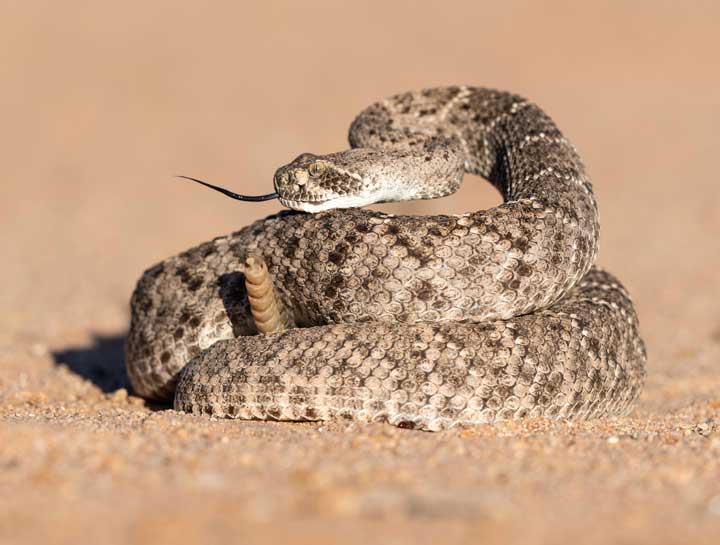Rattlesnake Pet Safety

January 1, 2020
Rattlesnakes 101
- Broad, triangular-shaped head with a narrow neck
- Cat-shaped eyes, folding fangs, +/- rattles at the end of their tail.
- Only venomous snake in California
- 8 types of rattlesnakes in California. Only 2 typically found in Northern California (Northern Pacific Rattlesnake and Great Basin Rattlesnake). The Western Diamondback is the most dangerous rattlesnake due to its size (usually 3-5 feet, but up to 7 feet long) and aggressiveness. The Mojave Green (found in areas in Southern California) is especially dangerous due to its neurotoxic venom.
- Rattlesnake venom contains 15-20 protein toxins.
Neurotoxins are toxic to nerves
Hemotoxins are toxic to blood cells. - In Northern California, rattlesnakes are especially active from March to September and will be less active when temperatures are below 50 degrees.
- 20-30% of bites are “dry” (i.e. no venom injected); 30% of bites have mild local symptoms (pain and swelling); 40% are severe; 5% fatal
- Large snakes inject a larger volume. Young snakes cannot control the amount of venom injected.
- Young snakes may have more neurotoxic elements while most adults have more hemotoxic elements
How to Keep Your Pets Safe
- At home, remove snake resources! Eliminate hiding places (wood and rock piles, underbrush, old sheds) and food sources (rodent populations). Consider snake fencing around your property, and be aware that snakes may enter garages and sheds.
- On walks, stay on wide trails and keep your dog on a leash. Avoid tall grass/brush and keep your dog from investigating under rocks and bushes. Be observant– especially at dusk and dawn.
- Teach your dog a “leave it” command. Ideally, attend an avoidance training course, which uses live muzzled or caged snakes and a shock collar. Courses are available statewide and are invaluable in teaching dogs to associate the sight, sound, and smell of rattlesnakes with a negative or unpleasant experience.
- If you encounter a snake, move slowly away. They can strike up to 3/4 of their length.
Signs/Symptoms of a Rattlesnake Bite
- Swelling at the site (often rapidly progressing and very severe)
- PAIN1-2 puncture wounds (or more if bitten multiple times)Bleeding and possible purplish discoloration of the skin or skin necrosisDrop in blood pressureParalysis if high levels of neurotoxins are injected. Paralysis of respiratory muscles can cause suffocation
- Most bites are on the face or extremities. Bites are more serious on the face or neck due to swelling which may impair breathing.
First Aid
- Stay CALM and keep animals quiet
- Wash the bite with water and soap
- Immobilize the bitten area and keep it lower than the animal’s heart
- Seek veterinary care immediately (Try to call the emergency clinic on your way if possible)
- Do NOT ice/cool the area
- Do NOT use a tourniquet
- Do NOT cut or suck the wound
Veterinary Treatment
- IV fluids to support blood pressure
- +/- Antihistamines
- +/- Steroids (if severe allergic reaction or anaphylaxis)
- Antibiotics
- Pain killers
- NO anti-inflammatory medications (may contribute to bleeding problems)
- Bloodwork and clotting times
- Antivenin
- Antibodies usually from a horse/sheep previously exposed to rattlesnake venom
- Given IV within 6-9 hours of a bite if indicated (severe bleeding, delayed clotting times, severe pain, and tissue damage)
- Binds the rattlesnake toxin to treat pain, prevent further tissue damage, and stop excessive bleeding
- Side Effects: May cause hypersensitivity, anaphylaxis, fever, muscle pain, itching
- Expensive ($800-1000/vial) and may require more than 1 vial to treat
- ???????Vaccination Controversy
- Crotalus atrox toxoid (Western Diamondback) with an aluminum hydroxide adjuvant and thimersal preservative.
- Vaccination licensure was received in California in 2003. USDA approval for nationwide usage in 2004. Not currently FDA approved.
- 2 doses given 4 weeks apart and then boosted annually in Spring, or 1 month prior to known exposure. Dogs with particularly high exposure may benefit from boosters every 6 months
- The vaccine appears to be fairly safe—up to 5% injection-site reactions, which are typically swellings or sterile abscesses
- No proven efficacy of vaccination
- Vaccinated dogs MAY have delayed onset of rattlesnake bite symptoms and MAY have less severe symptoms overall. Does NOT prevent bite symptoms.
- Vaccinated dogs MUST seek veterinary care immediately and will have the same treatment course as non-vaccinated dogs.
- Consider this vaccination IF your pet is at high risk or in an area where treatment may be substantially delayed.
- Avoidance classes are probably the most effective prevention against rattlesnake bites.
- Do not have a false sense of security. Rattlesnake bites are always an emergency!
